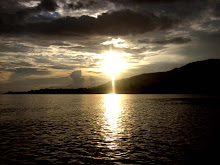Luneta and Intramuros are among the must-sees in Metro Manila. Not only are these places a stone’s throw from the dock along Roxas Boulevard where you can view the famous Manila Bay sunset, which, in itself is a must-see, but are also of historical significance.
After attending a book launching at La Salle Taft one Saturday morning in September 2006, my friends and I decided to spend our afternoon in Luneta. And here are snippets of what I remember of that stroll which we all enjoyed, despite the fact that we went home with aching feet and head because we weren’t dressed for walking (Tayns and I were wearing high heeled sandals) and we got rained on.
The National Museum

Our first stop was the national museum along P. Burgos. The museum showcases artifacts recovered from ship wreckages; among them, the San Diego. The finds at the said shipwreck are said to have provided proofs that before the coming of the Spaniards, there had been an active trade between the Philippines and its neighboring countries. The artifacts from the shipwrecks serve as proofs to the theory that the early Filipinos were seafarers. The theory was made long before physical proofs to support or disprove it were unearthed, and basing mainly on the fact that the country is surrounded by significant bodies of water.Also at the museum are artifacts that give us a glimpse of the life of the early Filipinos (suits, accessories, implements, and so on), and works of art, such as paintings and sculptures.
Heroes’ Shrines and Sculptures

The main attraction is the national hero’s shrine, but there are a lot of other monuments and sculptures in the park. Of these, the one that caught our attention was the Lapu-lapu monument, (Sentinel of Freedom) not only because it was almost as big as Jose Rizal’s, but also because it was the newest addition when we were there (it was inaugurated on February, 2004).
Speaking of Jose Rizal, would you know why his monument is guarded? My bet was to show honor to the national hero, until Salve pointed out it is really the gold at the top of the monument they are guarding. (Now, please don’t quote me. I am still in doubt. J)
A sculpture of note in the park is the La Madre Filipina, not only because it looked as if it was recently repainted, but also because it has personal significance to me. It was the piece my Dungngo and I tried to interpret when I toured him around the park months before my and my friends’ visit.
Parks within a park

It was not before our magazine (Ces’t La Vie) did a feature on parks in Metro Manila that I learned of the existence of parks inside Luneta. Just a few meters from the National Museum is the Chinese park, and not far from it are the Orchidarium and the Japanese parks. These places are a perfect respite for tired and weary souls, for despite the fact that a busy road is nearby, thick canopy of old trees muffles the sound of the roaring vehicles.
Fort Santiago/Intramuros
Fort Santiago/Intramuros

Not far from Luneta is the walled city (Intramuros) and Fort Santiago, Fort Santiago which served as the military headquarters of our conquerors (Spanish, British, American and Japanese and where Dr. Jose Rizal was imprisoned from November 3, 1896 until his execution on December 30 of that year. Besides Dr. Jose Rizal, hundred others were jailed and tortured here.
Some Tips
Those who seriously want to see the place to re-visit history, I suggest you start from the walled city, then Fort Santiago. From there, you can re-trace Jose Rizal’s steps when he was brought out and made to march to Bagumbayan (Luneta) towards death on 30 December 1986. There are brass shoeprints that trace the path Rizal took when he walked to his execution site.
Also, to have a better feel of the area, you might want to take the calesa ride on your way to Luneta. You may want to start with the museum, pass through the gardens, admire the sculptures and eat street food while walking from one piece of stone to another, but do try to catch the light show of the execution. (I watched it in 1998 together with my classmates in PI 100 and if I remember it right, it is shown every 6pm, although I suggest you inquire about it first; it’s been a long time since J.)
If you’d rather not watch the execution, you’d better make an appointment with the setting sun. The best place to watch it is at Baywalk, along Roxas Boulevard.
Sherma E. Benosa
//03 February 2008; 1:56am
Some Tips
Those who seriously want to see the place to re-visit history, I suggest you start from the walled city, then Fort Santiago. From there, you can re-trace Jose Rizal’s steps when he was brought out and made to march to Bagumbayan (Luneta) towards death on 30 December 1986. There are brass shoeprints that trace the path Rizal took when he walked to his execution site.
Also, to have a better feel of the area, you might want to take the calesa ride on your way to Luneta. You may want to start with the museum, pass through the gardens, admire the sculptures and eat street food while walking from one piece of stone to another, but do try to catch the light show of the execution. (I watched it in 1998 together with my classmates in PI 100 and if I remember it right, it is shown every 6pm, although I suggest you inquire about it first; it’s been a long time since J.)
If you’d rather not watch the execution, you’d better make an appointment with the setting sun. The best place to watch it is at Baywalk, along Roxas Boulevard.
Sherma E. Benosa
//03 February 2008; 1:56am






No comments:
Post a Comment